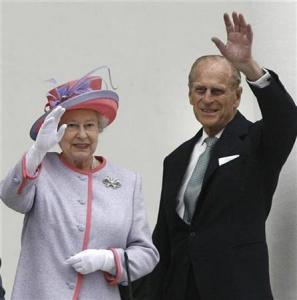
Queen Elizabeth and her consort Prince Philip visit Richmond, Virginia, May 3, 2007.
Prince Philip of England’s upbringing was far from normal. He was born June 10, 1921, on a kitchen table on the Greek island of Corfu in a house that had no electricity, hot water, or indoor plumbing. The only son and fifth and final child of Princess Alice of Battenberg and Prince Andrew of Greece and Denmark was christened Prince Philippos of Greece and Denmark. The platinum blond toddler learned sign language to communicate with his deaf mother.

Prince Philip (center) with parents, ca. 1923 (Lisa’s History Room)
Prince Philip of Greece’s father was a professional soldier in the Greek Army. With the Greek defeat in Asia Minor in 1922, Prince Andrew was accused of treason; he was tried, convicted, and jailed and faced possible execution by firing squad. Princess Alice (known as Princess Andrew to English speakers) appealed to her British relative, King George V, for help. Remembering what had happened to his Russian cousin the Tsar when he had refused his cry for rescue, the King quickly dispatched the HMS Calypso to remove Andrew, his wife, their four daughters, and Baby Philip from Greece. Prince Andrew boarded the ship carrying his 18-month-old son in an orange crate. They sailed for France.
For the next eight years, Prince Philip’s family lived in exile in Paris. Philip learned to speak English, French, and German, but no Greek. His family was royal – but not rich – and depended upon the charity of relatives and friends to feed, house, clothe, and educate them while in exile from their mother country.

Prince Philip of England’s family poses for a photograph October 1928. A young Prince Philip stands to the right of his mother, Princess Alice and Prince Andrew of Greece and Denmark. From left to right are Philip’s sisters, all Princesses of Greece & Denmark: Margarita, Theodora, Sophie, and Cecilie.
In 1930-31, the family fell completely apart. All four of Philip’s sisters, who were educated in Germany, married German noblemen and moved to Germany. Then Prince Andrew abandoned his wife and Philip and ran off to live with his mistress on her yacht anchored in the Mediterranean off Monte Carlo where Andrew quickly became addicted to the gaming tables.
Philip’s mother collapsed under the strain. She suffered a nervous breakdown and was institutionalized in Switzerland at the famed Bellevue Sanatorium. That left little Philip all alone in Paris, with no one to care for him. He was only nine.
Philip was then sent to England to be cared for by his maternal grandmother. But then she died. Next he moved in with his Uncle George, who, by 1938, was dead also. Philip was 17 at the time.
Then another of his maternal uncles, Lord Louis Mountbatten, British sea lord and the last Viceroy of India stepped in and took Philip under his wing. “Uncle Dickie” took an intense interest in his promising nephew. He made grand plans for him.

Prince Philip as a young midshipman in the Royal Navy, ca. late 1930s
Even though Philip was a Greek citizen, Uncle Dickie pulled a few strings so that Philip could join the Royal Navy as a midshipman. Then Uncle Dickie began to pave the way for Philip to marry the future Queen of England. In 1939, he arranged for Philip to entertain King George VI‘s two daughters, Princesses Elizabeth and Margaret, while the King and Queen Elizabeth toured Dartmouth Naval College.
When Princess Elizabeth met Philip, she was only 13. She fell head-over-heels in love with the tall, handsome, and athletic young man. The two became pen pals and wrote constantly to one another during the next six years of world war. He celebrated the Christmas of 1943 with her and her family at their Scottish estate, Balmoral. The press hailed the romance as the love match of the century.
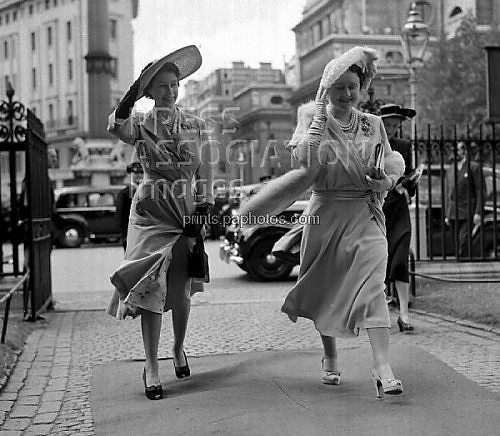
In this July, 1951 photo (a year before King George VI’s death and Princess Elizabeth’s ascension to the British throne), Princess Elizabeth and her mother, Queen Elizabeth, arrive at Westminster Abbey to attend the wedding of Lady Caroline Montagu-Douglas-Scott to Mr. Ian Hedworth Gilmour. Princess Elizabeth’s mother – who styled herself “Queen Elizabeth, the Queen Mother,” after her daughter became Queen Elizabeth II – had a fussy, overdressed sense of fashion. Her hats were generally broadbrimmed, trimmed in lace or swaths of chiffon, or piled high with feathers. Her neckline was often V-shaped and adorned with her trademark triple strand of pearls. Her dresses were feminine, flirty, and accented by enormous brooches and rings. As she aged, she dressed in fruity colors like pink, lime, and yellow. Her dresses and hats always matched in color. Her girlish style, peaches-and-cream complexion, pudginess, and sunny smile suggested a sweetness and wholesomeness that made her extremely popular at home and abroad. The Queen Mother, nee Elizabeth Bowes-Lyon, died in her sleep in 2002 at the age of 101. (Lisa’s History Room)
It was no surprise when, on July 9, 1947, the Palace announced that Prince Philip of Greece and Princess Elizabeth of Great Britain were officially engaged. Philip was 26; Elizabeth, 21. The wedding was set for November 20, 1947, at Westminster Abbey. The King and Queen were not wild about the idea of Elizabeth marrying before the age of 25, but it didn’t matter what they wanted. Elizabeth wanted Philip and she was going to have him.

Princess Elizabeth of Great Britain and Prince Philip of Greece announce their engagement, July 9, 1947. (Lisa’s History Room)
Buckingham Palace shifted into high gear planning the royal wedding:
“This was not simple a marriage ceremony, but an affair of state that would focus world attention on the British monarchy. Consequently the King and Queen told him [Prince Philip] that his sisters and their German husbands, some of whom had supported Hitler’s Third Reich, could not possibly be included. So they remained in Germany and listened to the service on the radio.” (1)
Still focused on the guest list, the Queen addressed the issue of Philip’s mother, Princess Andrew, whom she considered “pleasant but odd.” Although Philip’s mother had had nothing to do with Philip since he was 9, Princess Andrew had nevertheless been quite busy while others raised her son. After several years of Swiss therapy in the early 1930s, she had rejoined society and taken up charitable works. During WWII, she saved a Jewish family named Cohen from being sent to the death camp by sheltering them in her Greek home.
After the war, Princess Andrew founded a religious order called the Christian Sisterhood of Martha and Mary dedicated to helping the sick and the needy in Greece. Princess Andrew became a nun, taking a vow of celibacy, although she had born 5 children. She had a habit – a nun’s habit – that she wore all the time. It consisted of a drab gray robe, white wimple, cord, and rosary beads. She was commonly referred to as “Sister Andrew.”
Queen Elizabeth was understandably terrified that Princess Andrew would show up at the wedding at Westminster Abbey wearing her nun’s habit and embarrassing the family in a large way. The Queen pressed the issue with Philip. As a result, Princess Andrew appeared at her son’s wedding wearing a demure hat and a simple silk dress, which the Queen later described as “very pretty and most appropriate.”
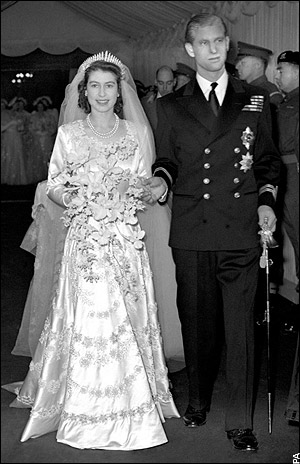
Princess Elizabeth and Prince Philip marry on November 20, 1947
Six years later King George VI was dead. Elizabeth and Philip returned to Westminster Abbey for Elizabeth to be crowned Queen.
The coronation was held on June 2, 1953 and televised, at Elizabeth’s request, so that all her subjects could see her crowned. Twenty million viewers watched the seven-hour BBC-TV marathon. The ceremony began as the guests began their stately procession down the long aisle of Westminster Abbey, ahead of the Queen, to take their seats.
Prince Philip’s mother was among the guests. She turned heads as she processed up the aisle wearing a long grey dress and a flowing head-dress that looked remarkably like a nun’s habit! She had had it especially made for the coronation.

Princess Andrew of Greece and Denmark, Prince Philip’s mother (bottom left) processes down the aisle of Westminster Abbey for her daughter-in-law Elizabeth’s coronation as Queen Regnant of Great Britain. June 1953. Princess Andrew is dressed in an outfit resembling her usual attire – a nun’s habit. (Lisa’s History Room)
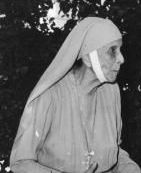
Princess Andrew, 1965
Princess Andrew died at Buckingham Palace in 1969. According to her wishes, she was buried in Gethsemane on the Mount of Olives in Jerusalem. On October 31, 1994, Princess Andrew’s two surviving children, Prince Philip and Sophie, Princess George of Hanover, went to Yad Vashem, the Holocaust Memorial, in Jerusalem to witness a ceremony honouring their mother. Princess Andrew was called “Righteous among the Nations” for having hidden a Jewish family in her home in Athens during WWII.
(1) Kelley, Kitty. The Royals. New York: Warner Books, Inc., 1997.
Read Full Post »




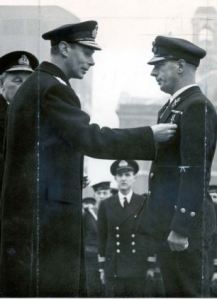









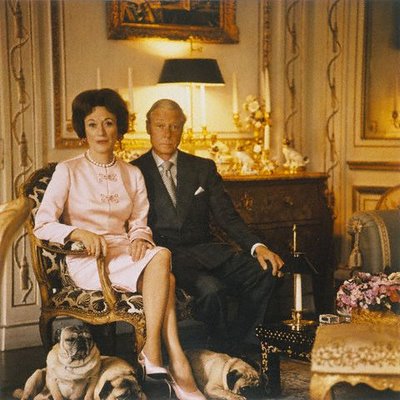















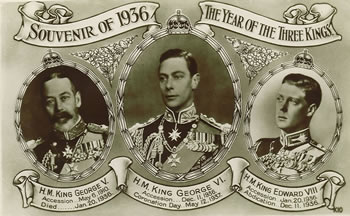
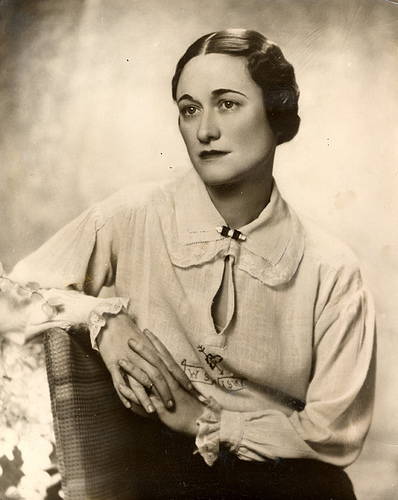
![Queen Mum "The Queen Mum" in later years. Queen Elizabeth II's mother died in 2002 at the age of 101. She hated the Duchess of Windsor and the Duchess of Windsor returned her sentiments, calling her the dowdy duchess [when the Queen Mum was the Duchess of York] and "Cake" for her confectionary style of dressing.](https://lisawallerrogers.files.wordpress.com/2009/10/queen-mum.jpg?w=468&h=524)



















